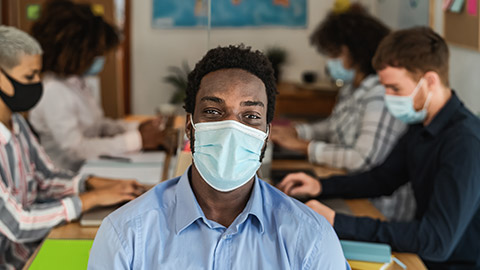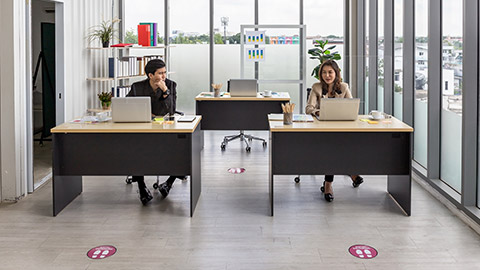Legislation for WHS (workplace health and safety), policies and procedures all aim to support the health and well-being of those who enter a workplace, are impacted by work activities or a combination of both. This includes employees, contractors, volunteers, clients, customers and visitors. The responsibility for WHS is shared between all parties involved. Please note that some regions use the phrase ‘workplace health and safety’ while others use ‘occupational health and safety.’
In this topic we will explore how WHS is legislated and regulated in Australia, including your rights and responsibilities for WHS and your employer’s duty to provide you with a safe workplace.
By the end of this topic, you will understand:
- commonwealth and state WHS legislation and codes of practices
- your rights and responsibilities with respect to WHS
- workplace policies and procedures and how they support safe work practices.
The International Labour Organisation and World Health Organisation Joint Committee on Occupational Health define WHS as:
The promotion and maintenance of the highest degree of physical, mental and social well-being of workers in all occupations.Forastieri, 2014
All work activities must be carried out in line with the relevant state or territory legislation. The Work Health and Safety Act 2011 is Commonwealth legislation that provides the basis for a nationally consistent WHS approach. Each state and territory have their own legislation regarding WHS as well as their own regulator. Regulators are responsible for regulating and enforcing WHS safety within their own jurisdiction. The acts and regulators in each state and territory are outlined in the following table:
| State or Territory | ACT | Regulator |
|---|---|---|
| Australian Capital Territory | Work Health and Safety Act 2011 (ACT) | WorkSafe ACT |
| New South Wales | Work Health and Safety Act 2011 (NSW) | SafeWork NSW |
| Northern Territory | Work Health and Safety (National Uniform Legislation) Act 2011 (NT) | NT WorkSafe |
| Queensland | Work Health and Safety Act 2011 (QLD) | Workplace Health and Safety Queensland |
| South Australia | Work Health and Safety Act 2012 (SA) | SafeWork SA |
| Tasmania | Work Health and Safety Act 2012 (TAS) | WorkSafe Tasmania |
| Victoria | Occupational Health and Safety Act 2004 (VIC) | WorkSafe Victoria |
| Western Australia | Occupational Safety and Health Act 1984 (WA) | WorkSafe WA |
The key aims for WHS legislation are to:
- Protect the health, safety and well-being of persons at work
- Eliminate risks to health, safety and the wellbeing of persons at work and the public
- Ensure that employers and workers collaborate on issues affecting workplace health and safety
- Assist employers in achieving a healthy and safe workplace
Definition of a Worker
The Work Health and Safety Act 2011 (Cwlth) uses the term ‘worker’ to encompass all people who carry out work in any capacity. This includes employees, volunteers, contractors and sub-contractors.
Codes of Practice
A code of practice is a guide approved under the Work Health and Safety Act 2011 (Cwlth). The purpose of codes is to provide practical advice on how to manage speci c risks in order to meet WHS standards outlined in legislation.
Commonly used codes of practice are:
- Health and Safety (How to Manage Work Health and Safety Risks) Code of Practice 2015
- Work Health and Safety (First Aid in the Workplace)Code of Practice 2015
- Work Health and Safety (Hazardous Manual Tasks) Code of Practice 2015
Read
A full list of codes approved under the Work Health and Safety Act 2011 (Cwlth) is available on the Australian Government’s Comcare website.
Activity
WHS Legislation and Regulation in AustraliaThe Model Workplace Health 2011 was developed by Safe Work Australia with the aim of providing a nationally consistent WHS framework to secure the health and safety of workers across Australia. In order for this act to be legally binding, it must be adopted into each state’s law.
Explore your state’s legislation and regulation structure in the Fundamentals of Workplace Health and Safety.
Infection Control in Healthcare
Those working in healthcare and community service settings need to be aware of the policies, procedures and standards related to infection control and prevention.
The National Health and Medical Research Council, in collaboration with the Australian Commission on Safety and Quality in Healthcare (NHMRC, n.d.), has produced guidelines for the prevention and control of infection in Australia’s healthcare. These guidelines help prevent disease-causing germs which spread in healthcare settings and make recommendations that address:
- Hand hygiene procedures
- Use of alcohol rubs and sanitisation products
- Processes for handling sharps
- Housekeeping, disinfection and cleaning procedures
- Use of personal protective equipment (PPE)
- Risk management procedures
Read
The guidelines from the National Health and Medical Research Council (NHMRC) and the Australian Commission on Safety and Quality in Healthcare were published in 2019 and are called The Australian Guidelines for the Prevention and Control of Infection in Healthcare. The guidelines are available on the NHRMC’s website.
A summary document of the guidelines is also available on the NHMRC’s website.
Activity
Infection Control Practices As outlined above, the NHMRC has developed guidelines that address a number of infection control practices and processes.
Consider your workplace or one with which you are familiar. What procedures are in place to reduce the chances of spreading infection? Write down your findings or discuss with your peers in the forum.

Your employer is obliged to develop policies and procedures to address WHS issues. These policies and procedures must detail how to minimise the risk or potential risk of injury, disease or other potential adversities that could impact a worker.
An employer’s policies and procedures must be supported by methods for ensuring that workers are aware of and clear on how to follow policies and procedures. Policies and procedures should include:
- Methods for consulting with employees regarding WHS representation and risk management
- Processes for identifying, reporting and addressing risks and hazards
- Staff WHS training and induction processes
- Site or organisation-specific information (for example, details on how to manage specific risks or hazards or how to use and maintain specific equipment
Procedures will ensure that you know:
- What is expected of you
- The rules and guidelines for decision-making in routine situations
- What response is clear and consistent across the organisation when dealing with situations
Your organisation’s policies and procedures are most likely developed from Safe Work Australia’s Code of Practice (Safe Work Australia, n.d.[A]), which is available on the Safe Work Australia’s website.
Follow workplace policies and procedures for safe work practices
When working in any organisation, ensuring the safety of all workers is a priority.
You need to know the risks, any dangers (hazards) and how to work safely in what can be busy, noisy situations.
Employers and workers need to work together, recognising hazards and making sure everyone follows safe work practices, every day, in every situation. In order to do this you need to have a good knowledge of workplace policies and procedures for WHS. Policies may include:
- Emergency evacuation
- Spill response
- Needlestick injury
- Manual handling and lifting
- Use of PPE
- Containment/quarantine
Of course there will be many more, but these are given as an example.
Here is an example of Bounce Fitness's Workplace Health and Safety Policy and Procedures.

The Commonwealth WHS legislation denes the health and safety responsibilities for a number of parties.
These ‘duty holders’ are summarised in the table below:
| Persons conducting a business or undertaking (PCBU) |
|
| Officers (for example, company directors) |
|
| Designers, manufacturers and suppliers |
|
| Workers |
|
Safe Work Australia, n.d. [A]
Employer’s Duty of Care
Your employer has a duty to all workers to ensure that the worker is safe from injury to risks and health while at work. This includes:
- Providing and maintaining a safe work environment
- Providing and following safe work systems
- Consulting with workers on how WHS is managed in the workplace (by establishing WHS committees or nominating WHS representatives, for example)
Safe Work Australia, n.d. [A]

Your Rights in Workplace Health and Safety
Right to a Safe Workplace
As a community services worker, you have the right to work in an environment that is free from hazards that may cause harm to your health or well-being. This includes a duty by your employer to provide a safe workplace.
Right to Information and Training
You have the right to access information, training, and resources related to WHS. Your employer should ensure that you are well-informed about potential risks, and they should provide training to equip you with the necessary skills to perform your job safely.
Right to Refuse Unsafe Work
In situations where you believe that your safety or the safety of others is at risk, you have the right to refuse to perform work that you reasonably believe to be unsafe. This is known as the "right to refuse unsafe work." It's important to follow the appropriate procedures for reporting your concerns when exercising this right.

Your Responsibilities in Work Health and Safety (WHS)
Duty of Care
You have a legal and ethical duty of care toward the clients you serve. This means you must take all reasonable steps to ensure their safety, health, and well-being while under your care.
Compliance with WHS Procedures
It is your responsibility to follow the WHS procedures and work instructions provided by your employer. These procedures are designed to prevent accidents, injuries, and illnesses. Examples may include client handling, infection control, and emergency response protocols.
Reporting Incidents and Hazards
You must promptly report any incidents, injuries, or hazards you encounter while performing your duties. This reporting is essential for addressing issues, preventing future accidents, and ensuring a safe work environment.
Contributing to a Safe Work Environment
As a community services worker, you should actively contribute to safe housekeeping practices in your work area. This involves keeping your workspace organized and free from hazards that could pose risks to you, your colleagues, or the clients.
Understanding your rights and responsibilities in Work Health and Safety is crucial for maintaining a safe and supportive environment in the community services sector. By balancing your rights with your obligations, you can contribute to the well-being of clients and ensure your own safety. Remember that ongoing training and adherence to WHS principles are essential for creating a culture of safety in your workplace.

Workplace Health and Safety (WHS) procedures are guidelines and protocols designed to prevent workplace accidents, injuries, and illnesses. Work instructions provide step-by-step guidance for performing specific tasks safely and effectively.
In community services, clients often face vulnerabilities, making safety a top priority. Implementing WHS procedures reduces risks, ensuring a safe and supportive client environment. So, what is the best way to implement safe work practices?
- Understand your role
It is important that you recognise the specific tasks and responsibilities within your role.
Watch the video below to gain a deeper understanding of what it takes to work as a Community Services worker. As the job role is so broad and diverse, it is so important that you understand what your role is in your organisation. In particular, what are your responsibilities in regard to WHS.
- Identify the applicable WHS procedure
Although there are overarching Workplace Health and Safety legislations, procedures will change from workplace to workplace.
Due to the nature of the job, physical structures, requirements for the organisation, etc, not all workplaces will have the same procedure.
This is why it is so important for you to check in with your place of work and request the procedures that you are required to understand for your job role.
Work with your supervisor or manager to identify WHS procedures relevant to your role.
Examples include client handling, infection control, emergency response, and equipment maintenance.
- Familiarise yourself with the procedure
Once you have identified the relevant procedures, it is up to you to become familiar with them.
An easy way to become familiar with them is by having them on hand. Either print them off (typically, workplaces will have a handbook of these) or have them around your place of work. While your conducting your safe work practices, follow along with the procedure.
- Seek training and skill development
Seek training and skill development opportunities to ensure you can perform tasks safely and effectively. Don't hesitate to ask questions or request additional training if needed.
Your employer is responsible for ensuring all workers are properly instructed and trained on how to do their work safely.
Your responsibility is to know all relevant health and safety information about your jobs, workplace, risks, and how to control them.
Training and instruction must be easy to understand, even for those whose first language is not English, and with additional needs such as literacy and hearing difficulties.
You need to:
- undertake induction and workplace safety training for when starting in a new workplace
- be trained for the specific tasks you will have to perform
- be appropriately supervised
- be supported by regular refresher training.
- Reporting and communication
If you encounter any issues, report them to your supervisor promptly. This includes incidents, near-misses, or suggestions for improvement.
Your workplace will have a procedure for reporting. This is one of the first questions you can ask when beginning a new role "How do I report incidents or near misses?".
- Continuous improvement
Participate in regular WHS reviews and updates. Share your experiences and insights to help improve safety procedures.
Most workplaces should have a WHS component in all staff meetings where you can collaborate and share information about WHS. Working together to continually improve the safety of your workplace is important.
Case Study
Sarah, is employed at a local nonprofit organization providing support services to elderly individuals. Sarah's role involves assisting the elderly residents with their daily activities, providing companionship, and ensuring their well-being. The organization is committed to maintaining safe work practices in the workplace and prioritizing the safety and health of both the clients and the staff.
Sarah starts her workday by checking in with her supervisor, who reminds her of the importance of following WHS procedures and work instructions. Sarah is assigned to assist an elderly resident, Mrs. Johnson, with her daily routine, which includes helping her with meals, medication, and mobility. As she assists Mrs. Johnson, Sarah encounters a situation where Mrs. Johnson nearly slips while attempting to walk without her walker.
Sarah immediately springs into action, ensuring Mrs. Johnson's safety by helping her regain her balance and reporting the near-miss incident to her supervisor. Her supervisor, in turn, ensures that the incident is documented according to workplace procedures and conducts a review to prevent future occurrences.
Throughout the day, Sarah consistently practices safe housekeeping by keeping walkways clear, ensuring spillages are cleaned up promptly, and properly storing hazardous materials. She also ensures that her personal protective equipment (PPE) is worn correctly.
The case study explores how Sarah's proactive and diligent approach to implementing safe work practices aligns with the specified learning outcomes. It showcases how her commitment to workplace safety not only benefits her but also ensures the well-being of the elderly residents under her care.
Answer the following questions.
Sarah's skill in identifying and implementing WHS procedures and work instructions plays a critical role in maintaining a safe environment for both the elderly residents and herself in her daily tasks. I can illustrate this with a hypothetical scenario:
Suppose I am working as a community service worker in a senior care facility, similar to Sarah's role. One day, I am assigned to assist a resident in transferring from their bed to a wheelchair. This seemingly routine task carries inherent risks, especially for the resident's safety and my own.
By following WHS procedures and work instructions, I ensure that I have the necessary equipment, such as a transfer belt and gloves, to perform the task safely. I also know the correct body mechanics and lifting techniques to prevent strain or injury. This proactive approach minimizes the risk of accidents and promotes a safe environment for the resident and me. It's through such training and adherence to procedures that we can maintain a safe and supportive atmosphere in the community service sector.
The ability to identify and report incidents and injuries promptly is a vital aspect of maintaining safety in the workplace, and it is particularly crucial in the community services sector. Let me illustrate its significance with a hypothetical scenario:
Suppose I'm working in a community service role at an assisted living facility, much like Sarah. One evening, while assisting a resident to their room, I notice a loose handrail on the staircase. Realizing that this could pose a safety risk to both residents and staff, I immediately take action.
First, I inform my supervisor about the issue and provide a detailed description of the problem. My supervisor acknowledges the concern and immediately reports it to the designated maintenance team following the workplace procedures. This swift response ensures that the handrail is fixed promptly, preventing a potential accident.
This example highlights how identifying and reporting incidents promptly is essential in the community service sector. It not only protects the safety and well-being of clients and staff but also upholds the organization's commitment to maintaining a safe environment. Timely reporting is a cornerstone of proactive risk management and a key component of a responsible and effective community service worker's role.
Safe housekeeping practices are absolutely crucial for maintaining a hazard-free environment in the workplace, as they play a significant role in preventing accidents and ensuring the safety of all individuals. I can highlight the importance of this skill with a hypothetical scenario:
Let's say I work as a support staff member in a daycare center, similar to Sarah's role. In this environment, maintaining a safe, clean, and organized workspace is paramount. One day, I notice that toys and play equipment are scattered across the floor in the playroom, creating potential tripping hazards for both the children and staff.
Understanding the importance of safe housekeeping practices, I take immediate action. I gather the toys, return them to their designated storage areas, and ensure that the playroom floor is clear and safe. This simple act of tidying up not only prevents accidents but also sets an example for the children, teaching them the importance of cleanliness and organization.
This example demonstrates how taking actions to maintain safe housekeeping practices in my work area contributes to overall workplace safety. It ensures a hazard-free environment, reduces the risk of accidents, and promotes a culture of safety that benefits everyone, from the staff to the clients.
In summary, this topic has provided a comprehensive overview of workplace health and safety (WHS) in Australia, emphasizing the shared responsibility of all parties involved, including employees, contractors, volunteers, clients, customers, and visitors. We've explored the legislative and regulatory framework governing WHS at both the Commonwealth and state levels. Additionally, we've discussed your rights and responsibilities regarding WHS, as well as your employer's duty to ensure a safe workplace. Furthermore, we've touched upon the international definition of WHS as the promotion and maintenance of the highest degree of physical, mental, and social well-being of workers across all occupations. As you conclude this topic, you should have a solid understanding of WHS principles and how they are applied in the Australian context, empowering you to contribute to a safer and healthier work environment.
